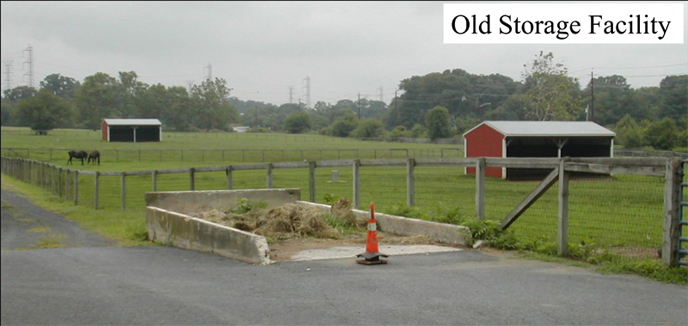
Old storage facility
Manure Storages on Equine Farms
Manure Storages on Equine Farms
Horse manure contains phosphorus (P), nitrogen (N), bacteria, and organic matter. Excess N can runoff the soil and pollute streams, potentially killing fish, it can also leach through the soil into groundwater where it may become a human health risk. Excess P can also run off the soil and pollute streams leading to accelerated vegetation growth and depressed dissolved oxygen levels. This can lead to bog odors, fish kills, more expensive water treatment, impacted recreation and toxic organisms (pfiesteria). Bacteria from organic waste can cause human illness and organic matter depletes aquatic dissolved oxygen and can lead to fish kills.
Proper manure storage is an essential link in a farm’s waste management plan. A good storage area will serve as a buffer and reduce risks from surface runoff related to overspreading on farm land.
Proper manure storage plays an important role in the Rutgers University Equine program. Storage is essential because it allows manure to be kept during the winter season when it is impossible to spread on fields. Stored manure will also result in more uniform spreading if manure is spread daily and should make better use of nutrients by allowing manure to be incorporated into the soil immediately after spreading. This would be impossible if spreading occurred every day.
The old manure storage facility was small, didn’t drain properly and resulted in the overflow running down the laneway, contaminating nearby pastures and it had become an eyesore. The amount of manure that could be stored was so small that it had to be removed frequently. As the number of horses increased at the facility it became necessary to replace the storage with a new, larger structure.
In 2005 we began working closely with the USDA-Natural Resources Conservation Service to design and build the structure. The new structure is 25 by 30 feet and has the capacity to hold manure and bedding from 17 horses kept in stalls for 24 hours a day for up to 45 days. This design allows for flexibility with animal density while maintaining environmental quality. The Ryders Lane facility is currently housing about 12 animals stalled for 12 hours a day.
The new structure is located farther from the barn, allowing for a vegetative buffer to be fenced off from animals. This buffer, composed of cool-season grasses to control and filter drainage, is at the back of the storage area. Drainage spaces in the back wall, along with the slope of the pit itself, allow runoff to proceed through the buffer, which will prevent contamination of animal movement lanes and local waterways. The drain holes prevent rainfall from pooling in the pit. The slight slope of the pit floor channels all water into the holes.
The vegetative buffer or filter area allows runoff nutrients from manure to be taken up by the plants in the filter and ensuring that no contaminated water enters movement lanes or waterways. This buffer was designed according to USDA-Natural Resources Conservation Service specifications for size and grass composition. The buffer extends 35 feet behind the pit down a gradual slope. The vegetative buffer is composed of cool-season grasses and legumes including white clover (2 lb/acre), orchard grass (6 lb/acre), and smooth brome (6 lb/acre). The buffer is fenced off from animals and only maintained with a mower as needed.
Consider:
Consider: